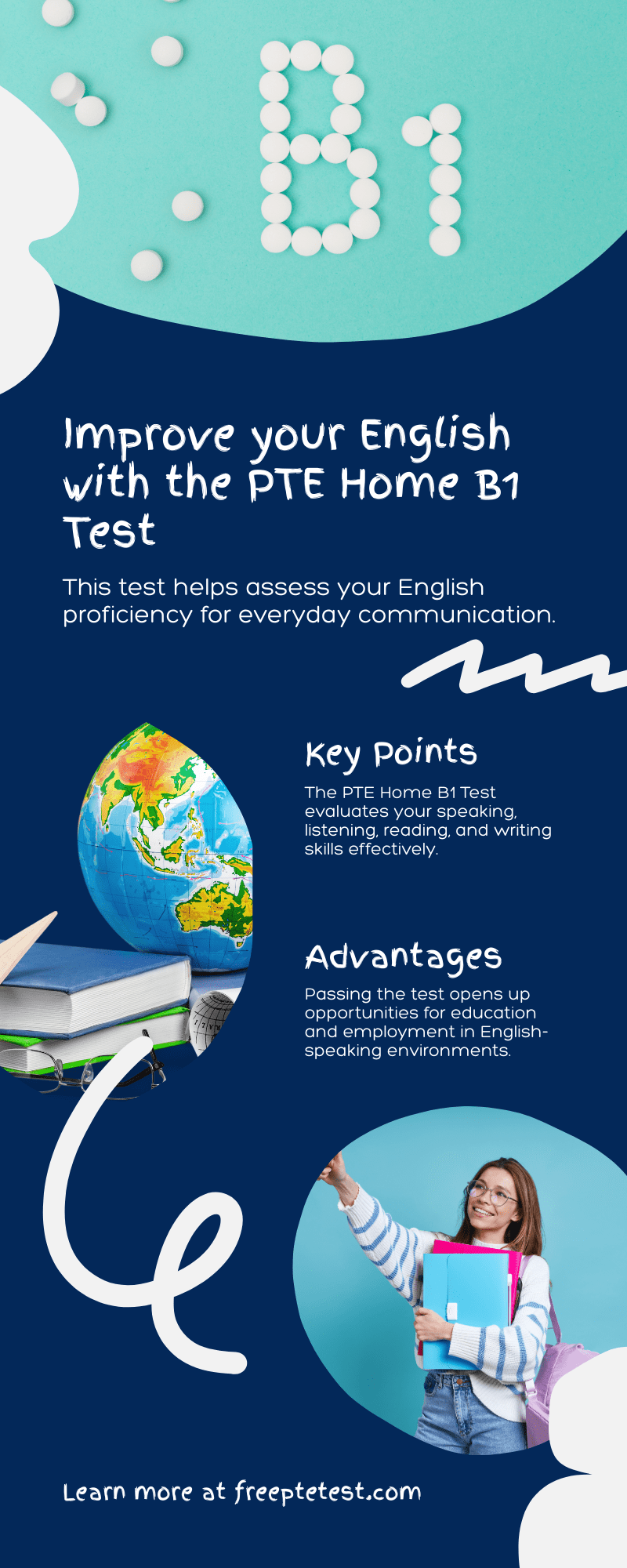As an experienced professional in preparing candidates for the Pearson Test of English (PTE), I have observed the significant impact of the PTE Home B1 Test on individuals seeking UK visas.
This computer-based examination, specifically designed to evaluate English language proficiency at the B1 level, assesses candidates’ ability to communicate effectively in practical, real-world contexts.
This guide offers a comprehensive examination of the PTE Home B1 Test’s structure, scoring methodology, preparation strategies, and updates as of August 2025, drawing on authoritative information from ptezone.com, freeptetest.com, and official Pearson resources.
The objective is to provide a clear and professional perspective that equips candidates with the knowledge and confidence needed to excel in this assessment.
What Is the PTE Home B1 Test?
The PTE Home B1 Test is a specialized version of the Pearson Test of English, tailored for candidates applying for UK visas, such as those for settlement (indefinite leave to remain) or citizenship.
The UK Home Office recognizes it as proof of English language proficiency at the B1 level, which corresponds to an intermediate ability to understand and use English in everyday situations.
Unlike the broader PTE Academic, which targets students and professionals, the PTE Home B1 is laser-focused on visa requirements, making it a concise yet rigorous assessment.
This computer-based test evaluates two key skills: Speaking and Listening. Unlike the PTE Academic, it does not include Reading or Writing sections, which makes it shorter, typically lasting around 29–30 minutes.
The test is taken online, requiring a stable internet connection, a computer with a microphone, webcam, and speakers, and a quiet environment to ensure accurate audio capture. With results delivered in as little as 48 hours (and up to 5 working days), it’s one of the fastest ways to prove your English proficiency for visa purposes.
Test Format and Structure
The PTE Home B1 Test is designed to be straightforward yet thorough, assessing your ability to communicate and comprehend spoken English. It consists of 29–32 tasks across four question types, completed in under 30 minutes. Below, I’ll break down each task type, drawing on insights from ptezone.com and freeptetest.com, to give you a clear picture of what to expect.
1. Repeat Sentence
- Number of Tasks: 17–18
- Description: You’ll hear a sentence (typically 3–9 seconds long) and need to repeat it exactly as you hear it. Your response is recorded and scored based on accuracy, pronunciation, and fluency.
- Time: About 15 seconds per task (3 seconds to listen, 12 seconds to respond).
- Focus: Tests your listening comprehension and oral accuracy.
- Tip: Focus on the sentence’s meaning to aid recall, and practice repeating short sentences to build confidence.
2. Describe Image
- Number of Tasks: 4–5
- Description: You’re shown an image (e.g., a photo, chart, or diagram) and have 25 seconds to describe it in detail. Your response is recorded and evaluated for content, pronunciation, and fluency.
- Time: 40 seconds per task (15 seconds to prepare, 25 seconds to speak).
- Focus: Tests your ability to articulate observations clearly.
- Tip: Use a structured approach—start with the main subject, then add details like colors or actions.
3. Respond to a Situation
- Number of Tasks: 4–5
- Description: You’re presented with a scenario (e.g., speaking to a colleague or making a request) and must respond appropriately in 40 seconds. The prompt is both spoken and written.
- Time: 50 seconds per task (10 seconds to prepare, 40 seconds to speak).
- Focus: Tests your ability to respond naturally in practical situations.
- Tip: Practice common scenarios like making requests or giving advice to sound natural and confident.
4. Summarize Spoken Text
- Number of Tasks: 4–5
- Description: You’ll hear an audio clip (40–90 seconds) and have 40 seconds to summarize its main points. Your response is recorded and scored for content accuracy, pronunciation, and fluency.
- Time: About 2 minutes per task (40–90 seconds to listen, 40 seconds to speak).
- Focus: Tests your listening comprehension and ability to condense information.
- Tip: Take brief notes while listening to capture key ideas, and practice summarizing short audio clips.
Key Features
- Duration: 29–30 minutes total.
- Scoring: Each task is scored on a scale of 0–5 based on content, pronunciation, and fluency, contributing to an overall score of 10–90 points.
- Delivery: Fully computer-based, with automated scoring for fairness and consistency.
- Retakes: No limit on retakes, but you must wait 5 days between attempts and pay a fee each time.
The test’s compact format makes it less daunting than longer exams like IELTS or TOEFL, but its fast pace requires sharp focus and preparation. The computer-based scoring ensures impartiality, as there’s no human bias—your performance is evaluated purely on accuracy and clarity.

Scoring and Results
The PTE Home B1 Test is graded on a scale of 10–90 points, with separate scores for Speaking and Listening and an overall score, which is the average of the two. The UK Home Office typically requires an overall score of at least 43 to meet B1-level proficiency for visa applications, though specific requirements may vary by visa type (e.g., settlement or citizenship). Each task is scored based on three criteria:
- Content: How accurately you address the task (e.g., repeating the sentence correctly or summarizing key points).
- Pronunciation: How clear and understandable your speech is.
- Fluency: How smoothly and naturally you speak, without excessive pauses or hesitations.
Results are delivered remarkably fast—often within 48 hours, and no later than 5 working days—making the PTE Home B1 ideal for candidates with tight visa deadlines. If your score falls short, you can retake the test after a 5-day waiting period, with no limit on attempts, though each retake requires a fee. Check ptezone.com for fee details, as costs vary by location.
Updates for 2025
As of August 2025, the PTE Home B1 Test remains a reliable option for UK visa applicants, with a few updates enhancing the test-taking experience. Based on information from ptezone.com, freeptetest.com, and official Pearson sources, here are the latest developments:
- Improved Online Booking: Pearson has streamlined the registration process on its myPTE portal, allowing you to book tests up to 24 hours in advance. This flexibility is a lifesaver for candidates with urgent visa needs.
- Enhanced Practice Resources: The myPTE account now offers expanded free resources, including introductory videos, practice tasks, and a Test Taker Handbook. These materials, emphasized on ptezone.com, help you understand the test format and question types.
- AI Scoring Refinements: Pearson’s automated scoring system has been fine-tuned for greater accuracy, ensuring your pronunciation and fluency are evaluated fairly. Freeptetest.com highlights this as a key advantage for consistent results.
- Global Availability: The test is now offered in more locations, with additional test centers and online proctoring options for remote candidates. Check ptezone.com for the latest list of test centers.
- Focus on Accessibility: Pearson has enhanced accommodations for candidates with disabilities, including adjustable audio settings and extended preparation time for specific tasks, upon request during registration.
These updates make the PTE Home B1 more accessible and user-friendly, reflecting Pearson’s commitment to meeting the needs of candidates. Always verify details on the official Pearson website (accessible via ptezone.com) before booking.
Preparation Strategies for Success
Preparing for the PTE Home B1 Test requires a blend of practice, strategy, and confidence-building. Drawing on my experience coaching candidates, here are practical tips to help you excel:
1. Understand the Test Format
Familiarize yourself with the four task types using free resources from ptezone.com and freeptetest.com. Practice with sample questions to get a feel for the timing and expectations. For example, try repeating sentences from audio clips or describing images to mimic test conditions.
2. Practice Active Listening
Since listening tasks (Repeat Sentence and Summarize Spoken Text) make up a significant portion of the exam, train your ear with English audio. Listen to UK-based podcasts or news (e.g., BBC) to familiarize yourself with British accents, which are common in the test. Freeptetest.com offers sample audio clips for practice.
3. Hone Speaking Skills
For Speaking tasks (Describe Image and Respond to a Situation), focus on clarity and fluency. Record yourself responding to sample prompts and listen for pronunciation errors or pauses. Practice speaking at a steady pace to sound natural, as advised on ptezone.com.
4. Develop Note-Taking Skills
In the Summarize Spoken Text task, jot down key points during the audio to aid your summary. Use abbreviations (e.g., “prob” for problem, “#” for numbers) to save time. Practice this skill with short audio clips to build speed and accuracy.
5. Simulate Test Conditions
Take full-length practice tests under timed conditions, using headphones and a microphone to replicate the test environment. Freeptetest.com offers free mock tests with AI scoring to assess your performance and identify weaknesses.
6. Manage Time Effectively
Each task has strict time limits (e.g., 40 seconds for Summarize Spoken Text). Practice answering within these constraints to avoid rushing on test day. If you’re unsure, prioritize content over perfection, as partial credit is possible for incomplete but accurate responses.
7. Build Confidence
Test anxiety can affect your speaking fluency. Practice relaxation techniques, like deep breathing, before starting. I often tell my students to treat the test like a conversation with a friend—speak naturally and stay calm.
8. Use Official Resources
Create a myPTE account to access Pearson’s free practice materials, including videos and sample questions. Ptezone.com also offers structured courses for more in-depth preparation, which can be a great investment if you need guided support.
Common Challenges and Solutions
Based on my coaching experience, here are common hurdles and how to overcome them:
- Difficulty Repeating Sentences: Some candidates struggle to recall exact sentences. Solution: Practice with short audio clips, focusing on meaning to aid memory. Repeat sentences immediately after hearing them to build muscle memory.
- Nervousness in Speaking Tasks: Speaking into a microphone can feel unnatural. Solution: Record yourself daily, describing images or responding to scenarios, to get comfortable with the format.
- Time Pressure in Summarize Spoken Text: The 40-second response time feels tight. Solution: Practice summarizing 60-second audio clips in 30–40 seconds, focusing on main ideas only.
- Unfamiliar Accents: The test may include varied English accents. Solution: Listen to UK media regularly to adapt to different pronunciations.
Why Choose the PTE Home B1 Test?
The PTE Home B1 Test stands out for its speed, flexibility, and fairness. Its 30-minute duration is less exhausting than longer exams like IELTS, allowing you to stay focused. The fast results (48 hours to 5 days) are ideal for urgent visa applications, and the computer-based scoring eliminates human bias.
Compared to other tests, such as IELTS or TOEFL, the PTE Home B1 is specifically designed for UK visa requirements, making it a targeted choice for applicants seeking settlement or citizenship.
From my experience, candidates who prepare strategically—focusing on task-specific practice and building confidence—often achieve their target scores on the first try. The test’s compact format rewards preparation, so invest time in understanding its nuances.
The PTE Home B1 Test is your gateway to proving B1-level English proficiency for UK visa applications. With its concise format, fast results, and updated resources, it’s a practical and accessible option for candidates.
By leveraging free materials from ptezone.com and freeptetest.com, practicing consistently, and adopting the strategies outlined above, you can approach the test with confidence and clarity.
Start your preparation early, stay focused, and treat each practice session as a step toward your UK visa goals. As a PTE expert, I’ve seen countless candidates succeed by embracing the process and trusting their preparation. You’ve got this—now go ace that test!



